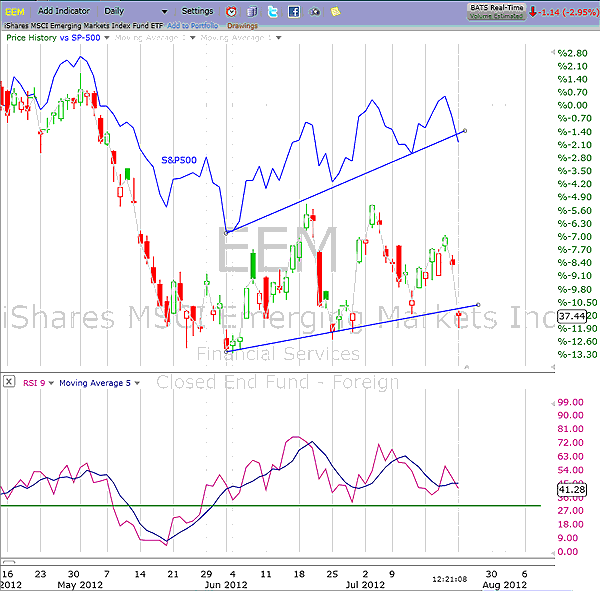
HOT TOPICS LIST
- MACD
- Fibonacci
- RSI
- Gann
- ADXR
- Stochastics
- Volume
- Triangles
- Futures
- Cycles
- Volatility
- ZIGZAG
- MESA
- Retracement
- Aroon
INDICATORS LIST
LIST OF TOPICS
PRINT THIS ARTICLE
by Matt Blackman
As the situation in Europe continues to deteriorate, there are signs that stock market challenges are not limited to bumbling politicians in that area alone.
Position: N/A
Matt Blackman
Matt Blackman is a full-time technical and financial writer and trader. He produces corporate and financial newsletters, and assists clients in getting published in the mainstream media. He is the host of TradeSystemGuru.com. Matt has earned the Chartered Market Technician (CMT) designation. Find out what stocks and futures Matt is watching on Twitter at www.twitter.com/RatioTrade
PRINT THIS ARTICLE
DIVERGENCE INDEX
Market Challenges Are Not Limited To Politicos In Europe
07/24/12 08:31:49 AMby Matt Blackman
As the situation in Europe continues to deteriorate, there are signs that stock market challenges are not limited to bumbling politicians in that area alone.
Position: N/A
| On Monday (July 23), stock markets in the US opened down mostly on the news that the Spanish government had banned short selling for three months. This announcement was a clear warning about how bad things in Europe were getting, and investors duly took note. As long as Eurozone bureaucrats continue to apply flimsy solutions to a problem that can only be solved by either a massive devaluation of the euro or, more logically, a controlled dissolution of the euro itself, the bad news will continue. Technically, however, there was another issue that was suffering more than US equities that at first glance didn't make sense. As US stocks were down 1.5%, emerging market stocks were down nearly double, prompting the obvious question. If European troubles were causing the problem, why were emerging markets getting hit so hard? See Figure 1. |

|
| FIGURE 1: EEM, DAILY. iShares MSCI Emerging Market ETF EEM with the S&P 500 (SPX). |
| Graphic provided by: FreeStockCharts.com. |
| |
| To find the answer, we need to look outside of global stock markets to an issue that has been a good historical indicator of the health of global economies: copper. Figure 2 is a weekly chart of "Dr. Copper" and the Standard & Poor's 500 showing how the industrial metal peaked in early 2011 and has dropped around 40% since then. Over the same period, the S&P 500 has gained more than 6%. Note the strong negative divergence between copper and the SPX. |

|
| FIGURE 2: MG132, DAILY. Chart comparing copper (MG132) and the S&P 500. Note the strong negative divergence between the two since early 2011. |
| Graphic provided by: FreeStockCharts.com. |
| |
| This example provides two powerful technical analysis lessons. First, when the fundamental news seems to be saying one thing, it pays to look to other asset classes for the real story. A short-selling ban in Europe should surprise no one, but it belies the real problem. Economies around the globe are weakening as copper and emerging stock markets are telling us. |
| Second, as discussed in my last Traders.com Advantage article ("The Fundamental Disconnect," July 18, 2012), this is another indication of the challenging market and economic conditions that we will face and if Martin Pring, author of "Investing In The Second Lost Decade" (McGraw Hill, 2012) is correct, will continue to have a lasting impact on markets into the 2020s. |
Matt Blackman is a full-time technical and financial writer and trader. He produces corporate and financial newsletters, and assists clients in getting published in the mainstream media. He is the host of TradeSystemGuru.com. Matt has earned the Chartered Market Technician (CMT) designation. Find out what stocks and futures Matt is watching on Twitter at www.twitter.com/RatioTrade
| Company: | TradeSystemGuru.com |
| Address: | Box 2589 |
| Garibaldi Highlands, BC Canada | |
| Phone # for sales: | 604-898-9069 |
| Fax: | 604-898-9069 |
| Website: | www.tradesystemguru.com |
| E-mail address: | indextradermb@gmail.com |
Traders' Resource Links | |
| TradeSystemGuru.com has not added any product or service information to TRADERS' RESOURCE. | |
Click here for more information about our publications!
PRINT THIS ARTICLE

|

Request Information From Our Sponsors
- VectorVest, Inc.
- Executive Premier Workshop
- One-Day Options Course
- OptionsPro
- Retirement Income Workshop
- Sure-Fire Trading Systems (VectorVest, Inc.)
- Trading as a Business Workshop
- VectorVest 7 EOD
- VectorVest 7 RealTime/IntraDay
- VectorVest AutoTester
- VectorVest Educational Services
- VectorVest OnLine
- VectorVest Options Analyzer
- VectorVest ProGraphics v6.0
- VectorVest ProTrader 7
- VectorVest RealTime Derby Tool
- VectorVest Simulator
- VectorVest Variator
- VectorVest Watchdog
- StockCharts.com, Inc.
- Candle Patterns
- Candlestick Charting Explained
- Intermarket Technical Analysis
- John Murphy on Chart Analysis
- John Murphy's Chart Pattern Recognition
- John Murphy's Market Message
- MurphyExplainsMarketAnalysis-Intermarket Analysis
- MurphyExplainsMarketAnalysis-Visual Analysis
- StockCharts.com
- Technical Analysis of the Financial Markets
- The Visual Investor
